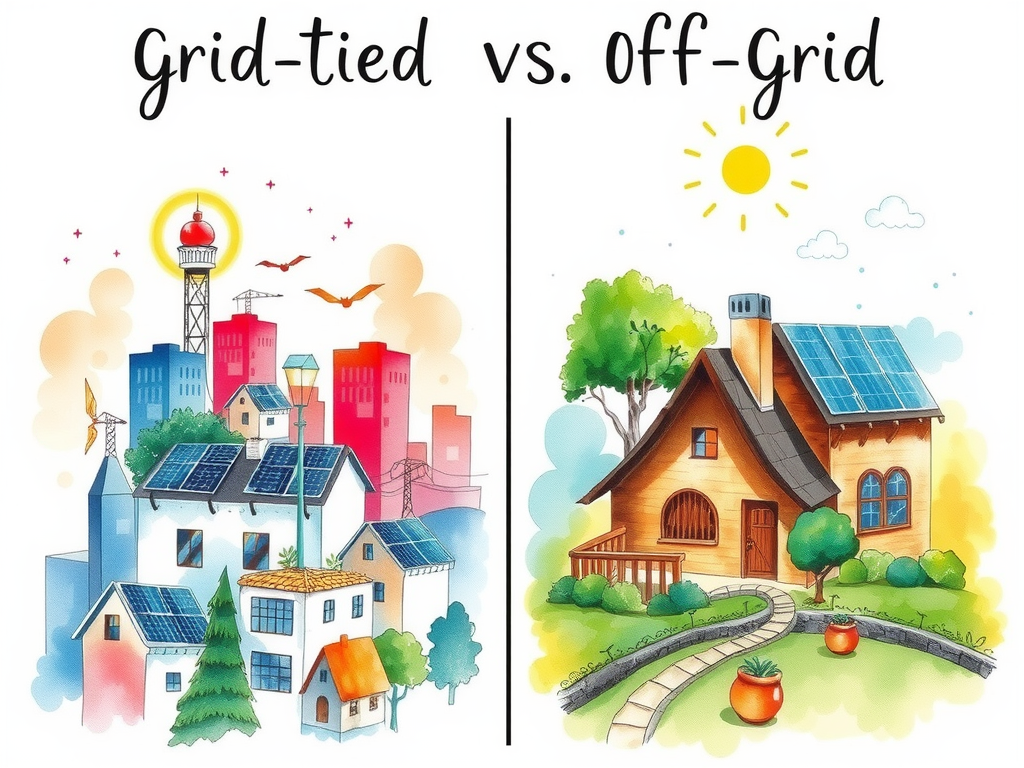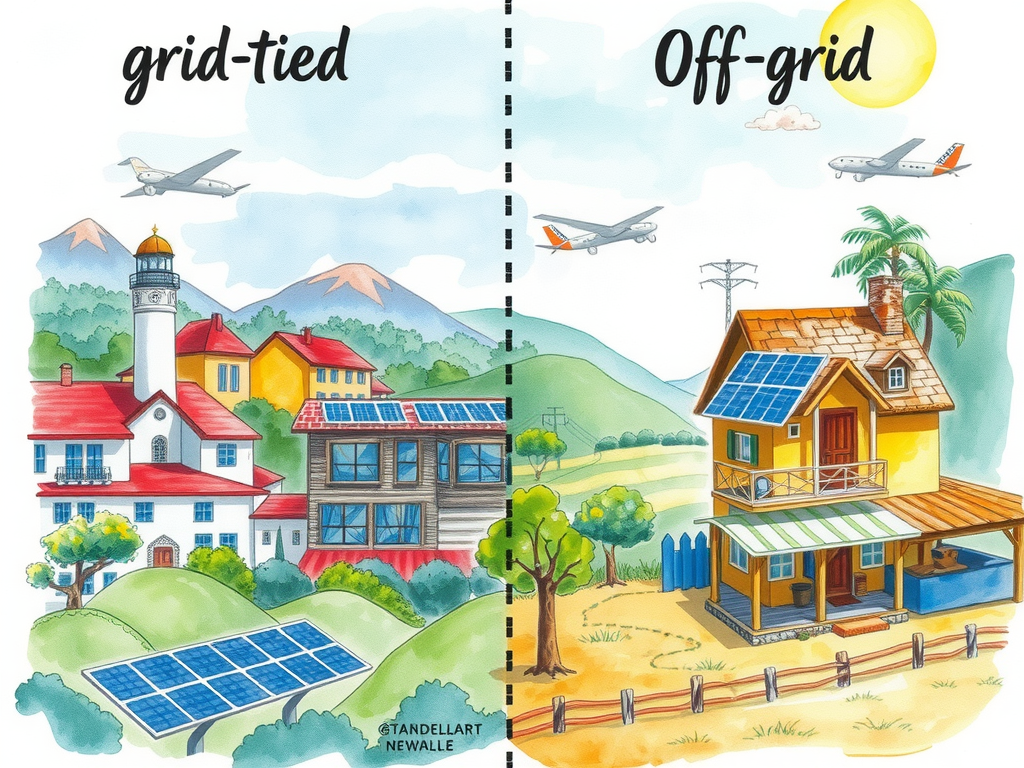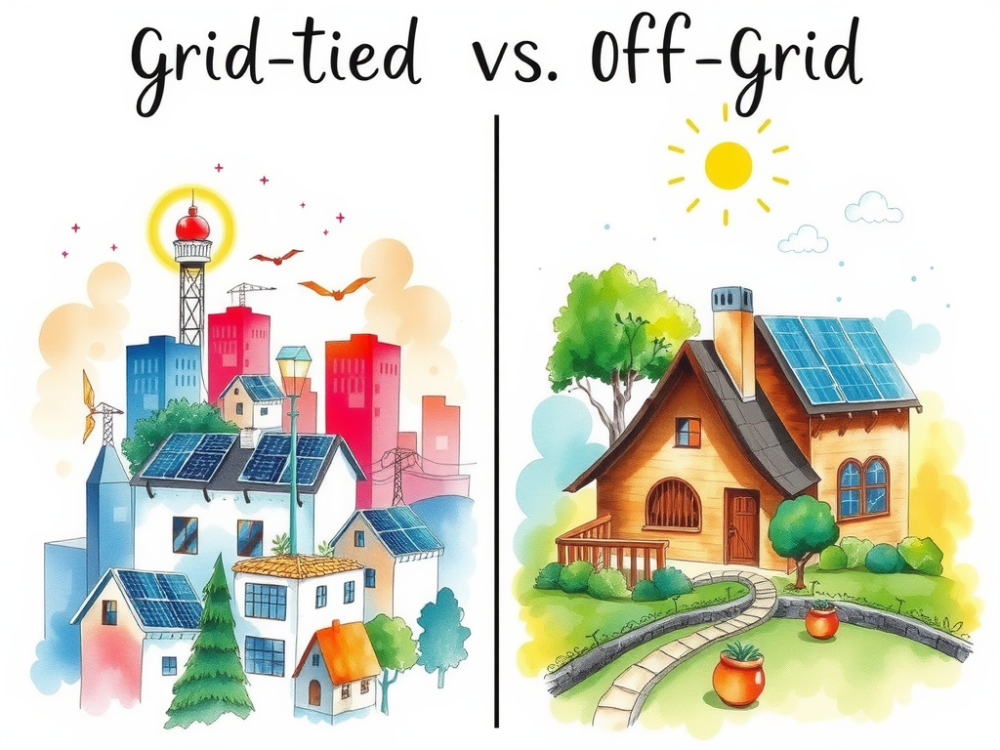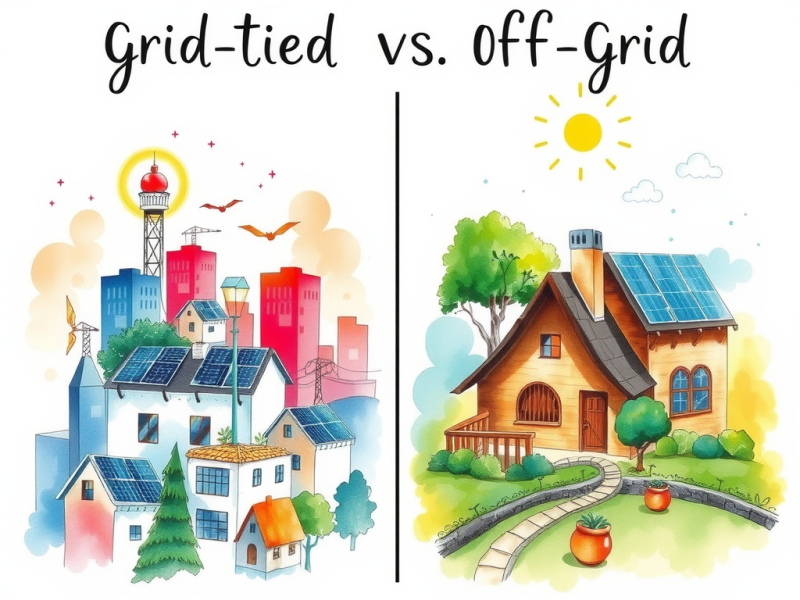
Solar energy provides options for energy solutions through grid-tied and off-grid solar systems. Grid-tied systems connect to the utility grid, allowing energy exchange.
Off-grid systems operate independently, offering energy autonomy.
Each system has different features tailored to user needs.
- Grid-tied systems connect to the utility grid for energy exchange.
- Off-grid systems operate independently, ensuring full energy autonomy.
Click here to learn more about: how to make homemade soap at home
Exploring Grid-Tied Solar Systems
Grid-tied solar systems improve energy efficiency by integrating solar power with the electricity grid. These setups utilize solar panels alongside grid electricity for a steady supply. When solar production is low, users depend on the grid for consistent power. Net metering allows homeowners to sell excess energy back to the grid, earning credits that lower electricity costs.
- Grid-tied systems increase energy efficiency and offer cost savings.
- Net metering provides credits for homeowners’ surplus power.
Benefits of Grid-Tied Systems
Grid-tied systems provide many advantages, such as:
- Lower installation and maintenance costs.
- Access to the grid for backup power during low solar production.
- Opportunities for financial returns through solar energy credits.

Reviewing Off-Grid Solar Systems
Off-grid solar systems are purely independent. They require batteries to store energy for use during non-sunny periods. These systems provide complete energy independence, making them ideal for remote locations. They typically involve higher upfront costs for battery storage and backup solutions.
- Off-grid systems guarantee independence from the utility grid.
- They can offer resilience against power outages but require significant initial investments.
Advantages of Off-Grid Systems
Off-grid solar systems have distinct benefits, including:
- Self-sufficiency in energy production and consumption.
- Uninterrupted power supply, regardless of grid status.
Choosing the Right System
The decision between grid-tied and off-grid solar systems depends on various factors. Consider your location, energy goals, budget, and level of desired independence. Grid-tied systems are often more affordable due to lower installation costs, while off-grid systems cater to those wanting complete control over their energy sources.
Evaluating your needs can lead to effective energy management and sustainability.
Benefits Of OffGrid Living
Off-grid living offers many benefits for those seeking energy independence and sustainability. Energy independence allows you to generate your own power without relying on the utility grid.
Utilizing renewable energy sources like solar panels enhances self-sufficiency while reducing your carbon footprint.
In fact, off-grid homes can cut emissions by up to 80%.
Choosing the right location for your off-grid setup is essential.
Here are some tips:
- Assess sunlight availability to maximize solar power generation.
- Check for available water sources to support your needs.
- Review local land regulations to ensure compliance.
These factors contribute to a successful transition into sustainable living.
How Energy Storage Works
Effective energy storage is key to achieving energy efficiency in off-grid living.
Battery technology enables users to store excess energy generated by renewable sources, making it available during low sun or wind periods.
Importance of Battery Technology
Different types of batteries, like lithium-ion, significantly impact energy performance and lifespan.
These batteries often last 10-15 years.
When choosing the right energy storage solution, evaluate your specific energy requirements and consider your budget.
Tips for Energy Management
Proper energy management ensures that your home remains powered sustainably.
Here are some strategies:
- Calculate your energy consumption to determine battery needs.
- Consider a battery bank suitable for your energy requirements.
- Look into solar incentives to reduce costs.
These measures enhance your energy resilience.
Off-Grid Living
- Off-grid homes can reduce emissions by up to 80%, contributing significantly to environmental sustainability.
- Battery technology, such as lithium-ion batteries, can last between 10 to 15 years, providing reliable energy storage solutions.
- Utilizing renewable energy sources enhances self-sufficiency and decreases reliance on non-renewable energy.
- Proper energy management can improve energy resilience and ensure sustainable power for your home.
Comparing Inverter Technologies
Choosing the right inverter technology is essential for maximizing solar power efficiency. String inverters are commonly used in grid-tied solar systems, converting direct current (DC) from solar panels into alternating current (AC) for home use.
Micro-inverters enhance performance by optimizing power at each panel level.
For example, selecting a micro-inverter can improve overall efficiency by up to 20% in shaded conditions.
Power optimizers also work with string inverters, boosting performance in less-than-ideal circumstances.
- String inverters: Efficient and cost-effective.
- Micro-inverters: Better performance in varying conditions.
- Power optimizers: Enhance string inverter efficiency.
The choice of inverter technology significantly impacts energy efficiency and the overall performance of a solar installation. This decision affects long-term electricity savings and energy independence.
What Is Net Metering
Net metering connects users to the utility grid and is an important feature of grid-tied systems. It allows users to earn credits for excess solar energy they produce and send back into the grid. This billing mechanism incentivizes the adoption of solar energy and promotes significant electricity savings.
Benefits of Net Metering
- Earn credits for surplus power.
- Save on electricity bills.
- Increase the financial return on your solar investment.
Check with your utility company to understand local regulations for net metering. This can help maximize your solar savings and ensure compliance with local guidelines. Understanding these policies can significantly impact your overall cost savings and energy management.
Inverter Technologies and Net Metering
- String inverters are the most widely used in residential solar installations due to their affordability and reliability.
- Micro-inverters can optimize energy production on a panel-by-panel basis, making them ideal for installations with shading issues.
- Net metering can significantly lower electricity bills, with some users reporting savings of up to 50% or more.
- Utility companies may offer different net metering rates, so checking local policies can maximize financial benefits from solar energy.
Exploring Energy Independence
Energy independence provides many benefits for those who choose off-grid living. Off-grid solutions allow users to create their own power, free from traditional utilities.
Renewable energy, especially solar power, is vital for achieving this independence.
For instance, the Sunshine Community in California successfully transitioned to a completely off-grid system.
This change resulted in an impressive 80% reduction in energy costs, demonstrating how effective renewable options can be for self-sufficiency. With energy efficiency technologies, individuals and communities can take control of their energy consumption and related costs.
Achieving energy independence fosters autonomy and significant cost savings.
Cost Savings With Solar Panels
Choosing solar panels can lead to significant long-term cost savings.
Solar energy helps lower electricity bills by using the sun’s power. Although the initial costs may appear high, most homeowners observe a return on their investment within a few years.
Energy storage options, like battery banks, improve solar system efficiency by storing excess power for future use.
Regular maintenance of solar panels is crucial for maintaining efficiency.
For example, keeping panels clean can enhance performance by up to 20%. By making smart investments, users can maximize electricity savings and enjoy reduced energy costs over time.
- Consider investing in energy storage to optimize usage.
- Monitor energy consumption for better management and savings.
- Utilize incentives for solar installation to reduce upfront costs.
Solar technology empowers homes with sustainable living and energy autonomy.
Energy Independence and Solar Power
- Off-grid living can lead to an 80% reduction in energy costs, as demonstrated by the Sunshine Community in California.
- Homeowners typically see a return on their solar investment within a few years, making it a financially sound choice.
- Regular maintenance of solar panels, such as cleaning, can improve efficiency by up to 20%.
- Energy storage solutions, like battery banks, enhance the overall efficiency of solar systems by allowing users to store excess energy for later use.
Environmental Impact Of Solar Energy
Solar energy has important effects on our environment. It reduces greenhouse gas emissions, which supports sustainable living.
Each megawatt of solar power can lower around 2,000 tons of carbon dioxide emissions annually.
The manufacturing of solar panels requires materials like silicon, which can lead to resource depletion.
Positive Impacts of Solar Energy
Communities that adopt community solar gardens show significant solar benefits.
These projects allow neighborhoods to share solar power resources. This increases access to renewable energy.
Community solar gardens promote both energy independence and sustainability. They showcase how solar energy can be a solution to environmental concerns.
Negative Impacts of Solar Energy
While solar systems offer benefits, they also present challenges.
The production process can impact air and water quality due to pollutants.
Solar panels have a life span of about 25-30 years, leading to waste issues when they are no longer usable.
Grid-Tied vs Off-Grid Solar Systems
Grid-tied and off-grid solar systems represent two main methods to harness solar energy.
Grid-tied solar systems connect directly to the local utility grid. They allow users to utilize both solar and grid electricity.
Off-grid solar systems operate independently and provide energy autonomy. They rely on battery storage for energy when sunlight is not available.
Characteristics of Grid-Tied Systems
Grid-tied systems are typically cheaper to install and maintain.
They benefit from net metering, earning credits for excess energy sent back to the grid.
Utility outages may affect these systems unless equipped with backup solutions.
Characteristics of Off-Grid Systems
Off-grid systems guarantee energy independence and are not affected by grid outages.
They require a higher initial investment for battery storage and backup power. These systems are ideal for remote locations or users seeking full energy autonomy.
Solar Energy
- Each megawatt of solar power can reduce approximately 2,000 tons of carbon dioxide emissions annually.
- Community solar gardens enhance access to renewable energy and promote energy independence.
- Solar panels typically have a lifespan of 25-30 years, raising concerns about waste management.
- Grid-tied systems benefit from net metering, allowing users to earn credits for excess energy supplied to the grid.





